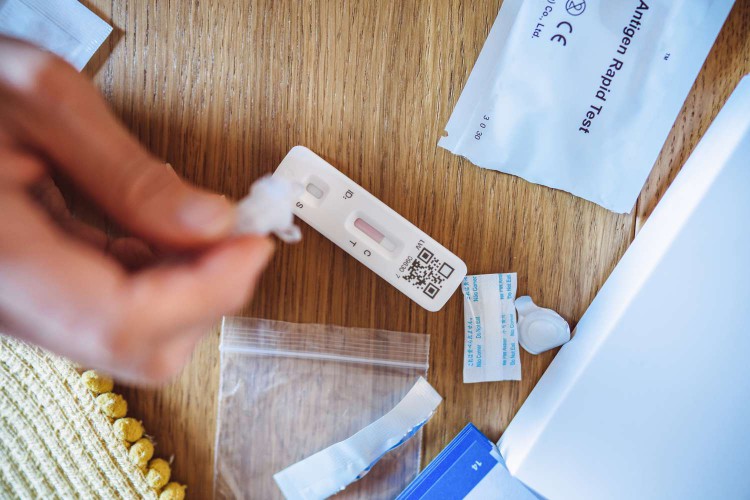- A new COVID-19 variant, BA.2.86 (nicknamed Pirola) may cause breakthrough infections, according to a new CDC risk assessment.
- There have been nine confirmed cases of BA.2.86 worldwide—two of those cases have been in the United States.
- Experts note that treatment options for older COVID variants may be able to treat this new strain as well; but with only nine confirmed cases, more information is needed.
A new COVID-19 variant may be more likely to cause breakthrough infection, according to the Centers for Disease Control and Prevention (CDC).
The CDC released a risk assessment Wednesday, breaking down information regarding the new variant.
“BA.2.86 may be more capable of causing infection in people who have previously had COVID-19 or who have received COVID-19 vaccines,” the assessment read. Meaning, it may be more likely to cause breakthrough infections than previous strains of the virus.
The CDC also broke down where the variant has been spotted, how severe an illness it may cause, and whether current treatments are effective against it.
Here's what experts currently know about BA.2.86.

Getty Images / AzmanL
What Is BA.2.86?
Nicknamed “Pirola,” BA.2.86 was first identified on July 24, 2023. The World Health Organization recently added the new variant to its list of “currently circulating variants under monitoring,” noting that the strain has a “large number of mutations identified.”
So far, nine cases of BA.2.86 have been detected—three in Denmark, two in South Africa, two in the U.S., one in the U.K., and one in Israel.
One of the cases in the U.S. was a person in Michigan, with the Michigan Health Department noting in a statement on X (formerly known as Twitter) that the patient who contracted the strain is an older adult with “mild symptoms” who hasn’t been hospitalized.
The Impact of BA.2.86 on Infection Rates
BA.2.86 is a subvariant of Omicron, which has been the dominant strain in the U.S. since late 2021, but “it has many, many more mutations than the mutations of each of the variants before,” Timothy Murphy, MD, senior associate dean for clinical and translational research at the University at Buffalo Jacobs School of Medicine and Biomedical Sciences, told Health.
Specifically, BA.2.86 has more than 35 amino acid changes to its spike protein than the recently circulating XBB.1.5, which the fall COVID-19 booster was based on, Murphy said.
The CDC pointed out that this change is “roughly of the same magnitude” as the switch between the Delta strain of COVID-19 and the initial Omicron variant, BA.1.
It's the spike protein mutations that make this variant likely to cause breakthrough infections.
“The virus uses the spike protein to bind the disease to cells,” Murphy said. “That’s what the vaccines are directed against.”
With so many mutations in the spike protein, there is a greater chance that the vaccine and having previously been infected with COVID-19 won’t offer as much protection against BA.2.86 as prior strains of the virus, William Schaffner, MD, an infectious disease specialist and professor at the Vanderbilt University School of Medicine, told Health.
“Initially, officials thought that BA.2.86 was not all that much different but, now that they’ve noted there are many mutations, they’ve at least raised the question about whether there may be some immune evasion on the part of this strain,” Schaffner said.
The CDC said it’s “too soon to know the real-world impacts on immunity” of BA.2.86. However, the agency noted that many people have immunity, either from previous infection, the vaccine, or both.
“It is likely that these antibodies will continue to provide some protection against severe disease from this variant,” the CDC said.
How Long Does It Take for the COVID-19 Booster To Be Effective?
Testing and Treating BA.2.86
While testing for COVID-19 is highly encouraged, new variants can be tricky to accurately test for.
“We have no lab data or experimental data whatsoever to say how this will impact immunity,” Murphy said. “It simply hasn’t been studied at this point, but likely will be soon.”
Samples of the new strain aren’t broadly available for reliable lab testing at this point, but are expected to happen eventually.
Meanwhile, existing treatments for older COVID-19 strains can most likely provide relief for patients who are infected with BA.2.86.
According to the CDC, the mutation profile of BA.2.86 suggests that treatments like Paxlovid, Veklury, and Lagevrio will be effective against the variant.
“The medications don’t target the spike protein—they go after different proteins in the virus and those do not appear to be any different,” Murphy said.
Schaffner agreed. “The treatments for sure ought to work, but we'll see whether over-the-counter tests continue to be able to detect this new variant as we go forward,” he said.
Overall, it's hard to say how different BA.2.86 is from other variants. The CDC stressed that there have just been nine cases, making it hard to know how infectious this variant is and how severe of an illness it may cause.
“There’s really zero information here,” Murphy said. “With nine cases, it’s just not enough to know anything.”
When To Get Boosted After Having a COVID-19 Breakthrough Infection








